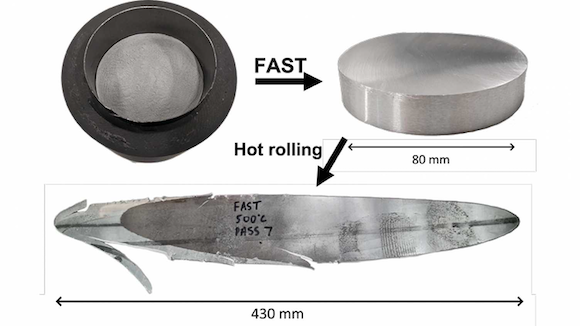University of Sheffield uses solid-state processing to transform surplus Al powders
October 26, 2022

Researchers from the Sheffield Titanium Alloy Research (STAR) group, part of the UK’s University of Sheffield, have partnered with ECKART GmbH, Schluechtern, Germany, to convert surplus aluminium alloy powders from atomisation into sheet material in two solid-state steps for use in aerospace applications. The project combined field assisted sintering technology (FAST) with hot rolling to convert surplus aluminium alloy powders from atomisation into sheet material in two solid-state steps. Eckart provided the A20X alloy powder used by the researchers.
Additive Manufacturing techniques are generally promoted as having reduced material wastage compared to conventional metallurgy, but the as-atomised particle size range is often overlooked as an issue. Business economics requires that alternative processes are utilised to convert these surplus powders into useful products, to ensure that the AM market is cost effective and meets sustainability targets. This key factor informs the foundation of this research.
Field Assisted Sintering Technology can provide an alternative solid-state processing route to consolidate these surplus powders into billets for subsequent processing. This enables the production of useful products from this feedstock, whilst also improving sustainability within the Additive Manufacturing supply chain.
This project goes a step further and combines FAST with hot rolling to convert surplus aluminium alloy powders from atomisation into sheet material in two solid-state steps. FAST can effectively consolidate the powder into fully dense billets, which are then hot rolled into sheets.
Through tensile testing, this project’s results revealed that the properties’ output from this process was comparable to conventional material which is used in aerospace applications.
Pre-existing research focused on FAST of metal powders assisted in the development of this project. This reportedly spurred a final year student project – designed by Dr Simon Graham, Research Associate MAPP – Future Manufacturing Hub and led by Alicia Patel, BEng Aerospace Engineering student – following the completion of this early-stage research, the project has been built upon in an effort led by Dr Graham.
The research has also been informed by works carried out in Sheffield relating to the processing of titanium powders which are oversized for Laser Beam Powder Bed Fusion (PBF-LB) Additive Manufacturing, where methods of crossover were identified to be of relevance. When reviewing existing literature, only one paper is thought to have been published which specialises in hot rolled, FAST produced, pure aluminium. Previously published research on A20X alloy has only considered AM or cast material.
Findings and potential impact
The research is said to have shown that FAST can rapidly consolidate aluminium alloy powders, including A20X, with a large particle size range into fully dense materials. The resulting 80 mm diameter A20X FAST were also successfully hot rolled from their initial 15 mm thickness down to 2 mm sheet, although some later optimisation is required to prevent edge defects within the sheet.
Some conventional cast A20X material – with the same starting dimensions – were also hot rolled under the same conditions. Tensile testing showed that – before and after the heat treatment – the FAST material exhibited similar properties to the cast and were comparable to other aluminium sheet used in aerospace applications.
These findings were presented by Dr Simon Graham at World PM2022 in a keynote titled ‘Solid-State Processing of Surplus Aluminium Alloy Powders through a Combination of Field Assisted Sintering Technology and Hot Rolling’.
The outcome of this project has demonstrated that there is a viable processing route to convert surplus alloy powders into sheet material with good mechanical properties. Although the long-term, positive, impacts cannot be quantified at this stage, there are clear economic impacts. These economic benefits relate to new revenue streams for atomisers, as well as a potential cost reduction of powders for Additive Manufacturing.
The next steps involve completing further rolling trials, to optimise the processing, and produce a higher quality sheet product. These sheets can also be extended in the starting phases, in a bid to produce larger sheets as an output, which further demonstrates scale up opportunities. Superplastic forming of the sheet material could also be considered to produce near-net shape components.














